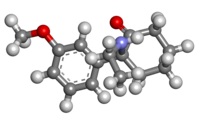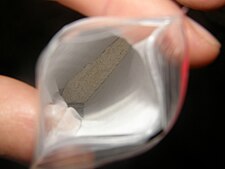Pharmaceutical compound
 | |
 | |
| Clinical data | |
|---|---|
| Other names | MXE; 3-MeO-2'-oxo-PCE |
| Addiction liability | High |
| Drug class | NMDA receptor antagonist; Dissociative hallucinogen; General anesthetic |
| ATC code |
|
| Legal status | |
| Legal status |
|
| Pharmacokinetic data | |
| Elimination half-life | 3–6 hours |
| Identifiers | |
IUPAC name
| |
| CAS Number | |
| PubChem CID | |
| ChemSpider | |
| UNII | |
| KEGG | |
| CompTox Dashboard (EPA) | |
| Chemical and physical data | |
| Formula | C15H21NO2 |
| Molar mass | 247.338 g·mol |
| 3D model (JSmol) | |
SMILES
| |
InChI
| |
| (what is this?) (verify) | |
Methoxetamine (MXE) is a dissociative hallucinogen that has been sold as a designer drug. It differs from many dissociatives such as ketamine and phencyclidine (PCP) that were developed as pharmaceutical drugs for use as general anesthetics in that it was designed specifically to increase the antidepressant effects of ketamine.
MXE is an arylcyclohexylamine. It acts mainly as an NMDA receptor antagonist, similarly to other arylcyclohexylamines like ketamine and PCP.
Recreational use
Effects

MXE is reported to have a similar effect to ketamine. It was often believed to possess opioid properties due to its structural similarity to 3-HO-PCP, but this assumption is not supported by data, which shows insignificant affinity for the μ-opioid receptor by the compound. Recreational use of MXE has been associated with hospitalizations from high and/or combined consumption in the US and UK. Acute reversible cerebellar toxicity has been documented in three cases of hospital admission due to MXE overdose, lasting for between one and four days after exposure.
MXE was designed in part in an attempt to avoid the urotoxicity associated with ketamine abuse; it was thought the compound's increased potency and reduced dose would limit the accumulation of urotoxic metabolites in the bladder. Like ketamine, MXE has been found to produce bladder inflammation and fibrosis after high dose chronic administration in mice, although the dosages used were quite large. Reports of urotoxicity in humans have yet to appear in the medical literature.
Pharmacology
Pharmacodynamics
| Site | Ki (nM) | Action | Species | Ref |
|---|---|---|---|---|
| NMDA (PCP) |
259 | Antagonist | Human | |
| MORTooltip μ-Opioid receptor | >10,000 | ND | Human | |
| DORTooltip δ-Opioid receptor | >10,000 | ND | Human | |
| KORTooltip κ-Opioid receptor | >10,000 | ND | Human | |
| NOPTooltip Nociceptin receptor | >10,000 | ND | Human | |
| σ1 | >10,000 | ND | Guinea pig | |
| σ2 | >10,000 | ND | Rat | |
| D2 | >10,000 | ND | Human | |
| 5-HT2A | >10,000 | ND | Human | |
| SERTTooltip Serotonin transporter | 481 2,400 (IC50) |
Inhibitor | Human | |
| NETTooltip Norepinephrine transporter | >10,000 20,000 (IC50) |
Inhibitor | Human | |
| DATTooltip Dopamine transporter | >10,000 33,000 (IC50) |
Inhibitor | Human | |
| Values are Ki (nM). The smaller the value, the more strongly the drug binds to the site. | ||||
MXE acts mainly as a selective and high-affinity NMDA receptor antagonist, specifically of the dizocilpine (MK-801) site (Ki = 257 nM). It produces ketamine-like effects. In addition to antagonism of the NMDA receptor, MXE has been found to act as a serotonin reuptake inhibitor (Ki = 479 nM; IC50 = 2,400 nM). Conversely, it shows little or no effect on the reuptake of dopamine and norepinephrine (Ki and IC50 > 10,000 nM). Nonetheless, MXE has been found to activate dopaminergic neurotransmission, including in the mesolimbic reward pathway. This is a characteristic that it shares with other NMDA receptor antagonists, including ketamine, PCP, and dizocilpine (MK-801). Animal studies suggest MXE may have rapidly-acting antidepressant effects similar to those of ketamine. A study that assessed binding of MXE at 56 sites including neurotransmitter receptors and transporters found that MXE had Ki values of >10,000 nM for all sites except the dizocilpine site of the NMDA receptor and the serotonin transporter (SERT).
Pharmacokinetics
MXE has a longer duration of action than that of ketamine.
Chemistry

MXE is an arylcyclohexylamine and a derivative of eticyclidine (PCE). It can also be thought of as the β-Keto-derivative of 3-methoxyeticyclidine (3-MeO-PCE), or the N-ethyl homologue of methoxmetamine (MXM) and methoxpropamine (MXPr). It is closely related structurally to ketamine, and more distantly to PCP.
MXE hydrochloride is soluble in ethanol up to 10 mg/ml at 25 °C.
Detection in body fluids
A forensic standard of MXE is available, and the compound has been posted on the Forendex website of potential drugs of abuse.
History
The qualitative effects of MXE were first described online in May 2010 and the compound became commercially available on a small scale in September 2010. By November the use and sale of the MXE had increased enough for it to be formally identified by the European Monitoring Centre for Drugs and Drug Addiction. By July 2011, the EMCDDA had identified 58 websites selling the compound at a cost of 145–195 euros for 10 grams.
Society and culture

Media coverage
Mixmag reported in January 2012, that people in the dance music and clubbing community have given MXE the slang name 'roflcoptr'. Vice commented that it was likely that the phrase will only be used by "the same politicians, parents and journalists" who called mephedrone 'meow meow'. After being called mexxy in UK Home Office press releases, the media adopted the name.
A literature review was published in March 2012 which looked at scientific literature and information on the web. It concluded that "the online availability of information on novel psychoactive drugs, such as MXE, may constitute a pressing public health challenge. Better international collaboration levels and novel forms of intervention are necessary to tackle this fast-growing phenomenon."
Legal status
Brazil
MXE became classified as a narcotic in Brazil in February 2014.
Canada
As of January 2010 MXE is a controlled substance in Canada.
China
As of October 2015 MXE is a controlled substance in China.
European Union
On 16 June 2014, the European Commission proposed that MXE be banned across the European Union, subjecting those in violation to criminal sanctions. This is following the procedure for risk-assessment and control of new psychoactive substances set up by the council: Decision 2005/387/JHA.
Finland
Scheduled in "government decree on narcotic substances, preparations and plants" and is hence illegal.
Israel
MXE became classified as an illegal narcotic in Israel in May 2012.
Japan
MXE became a controlled substance in Japan from 1 July 2012, by amendment to the Pharmaceutical Affairs Law.
Poland
MXE is a controlled substance (group II-P) making it illegal to produce, sell or possess in The Republic of Poland as of 1 July 2015.
Russia
MXE has been a controlled substance in Russia since October 2011.
Sweden
MXE became classified as a narcotic in Sweden in late February 2012.
Switzerland
MXE has been illegal in Switzerland since December 2011.
United Kingdom
Prior to March 2012, MXE was not controlled by the UK's Misuse of Drugs Act. In March 2012, the Home Office referred MXE to the Advisory Council on the Misuse of Drugs for possible temporary controlling under the powers given in the Police Reform and Social Responsibility Act 2011. The ACMD gave their advice on 23 March, with the chair commenting that "the evidence shows that the use of methoxetamine can cause harm to users and the ACMD advises that it should be subject to a temporary class drug order." In April 2012, MXE was placed under temporary class drug control, which prohibited its import and sale for 12 months.
Theresa May commented in her reply to the ACMD that "the next step in this process is for the ACMD to undertake a full assessment of MXE for consideration for its permanent control under the 1971 Act." She goes on to say that she hopes the ACMD will do this as a part of the review of ketamine, "including its analogues" and that this review will be completed "within the 12 months from the making of the current order".
On 18 October 2012 the ACMD released a report about MXE, saying that the "harms of methoxetamine are commensurate with Class B of the Misuse of Drugs Act (1971)", despite the fact that the act does not classify drugs based on harm. The report went on to suggest that all analogues of MXE should also become class B drugs and suggested a catch-all clause covering both existing and unresearched arylcyclohexamines.
MXE ceased to be covered by the temporary prohibition on 26 February 2013, when it became classified as a Class B drug.
United Nations
MXE was made a schedule II drug in November 2016.
United States
On June 6, 2022, the U.S. Drug Enforcement Administration published a final rule placing MXE in Schedule I of the Controlled Substances Act.
References
- ^ Kjellgren A, Jonsson K (2013). "Methoxetamine (MXE)--a phenomenological study of experiences induced by a "legal high" from the internet". Journal of Psychoactive Drugs. 45 (3): 276–286. doi:10.1080/02791072.2013.803647. PMC 3756617. PMID 24175493.
- "Federal Register". FederalRegister.gov. 6 June 2022. Retrieved 21 June 2022.
- Anvisa (24 July 2023). "RDC Nº 804 - Listas de Substâncias Entorpecentes, Psicotrópicas, Precursoras e Outras sob Controle Especial" [Collegiate Board Resolution No. 804 - Lists of Narcotic, Psychotropic, Precursor, and Other Substances under Special Control] (in Brazilian Portuguese). Diário Oficial da União (published 25 July 2023). Archived from the original on 27 August 2023. Retrieved 27 August 2023.
- "Substance Details Methoxetamine". Retrieved 22 January 2024.
- ^ EMCDDA Annual Report 2010 (PDF) (Report). European Monitoring Centre for Drugs and Drug Addiction. 2010. Archived (PDF) from the original on 14 March 2012. Retrieved 23 January 2012.
- ^ Morris H, Wallach J (2014). "From PCP to MXE: a comprehensive review of the non-medical use of dissociative drugs". Drug Testing and Analysis. 6 (7–8): 614–632. doi:10.1002/dta.1620. PMID 24678061.
- ^ Morris H (11 February 2011). "Interview with a ketamine chemist: or to be more precise, an arylcyclohexylamine chemist". Vice Magazine. Archived from the original on 30 January 2012. Retrieved 23 January 2012.
- ^ Roth BL, Gibbons S, Arunotayanun W, Huang XP, Setola V, Treble R, Iversen L (2013). "The ketamine analogue methoxetamine and 3- and 4-methoxy analogues of phencyclidine are high affinity and selective ligands for the glutamate NMDA receptor". PLOS ONE. 8 (3): e59334. Bibcode:2013PLoSO...859334R. doi:10.1371/journal.pone.0059334. PMC 3602154. PMID 23527166.
- Wood DM, Davies S, Puchnarewicz M, Johnston A, Dargan PI (May 2012). "Acute toxicity associated with the recreational use of the ketamine derivative methoxetamine". European Journal of Clinical Pharmacology. 68 (5): 853–856. doi:10.1007/s00228-011-1199-9. PMID 22205276. S2CID 4084801.
- ^ Shields JE, Dargan PI, Wood DM, Puchnarewicz M, Davies S, Waring WS (June 2012). "Methoxetamine associated reversible cerebellar toxicity: three cases with analytical confirmation". Clinical Toxicology. 50 (5): 438–440. doi:10.3109/15563650.2012.683437. PMID 22578175. S2CID 40114091.
- ^ "Pair hospitalised after taking designer drug mexxy". BBC News. 7 April 2014. Archived from the original on 12 April 2014.
- Dargan PI, Tang HC, Liang W, Wood DM, Yew DT (March 2014). "Three months of methoxetamine administration is associated with significant bladder and renal toxicity in mice". Clinical Toxicology. 52 (3): 176–180. doi:10.3109/15563650.2014.892605. PMID 24580056. S2CID 34284740.
- Roth BL, Driscol J. "PDSP Ki Database". Psychoactive Drug Screening Program (PDSP). University of North Carolina at Chapel Hill and the United States National Institute of Mental Health. Retrieved 14 August 2017.
- ^ Hondebrink L, Kasteel EE, Tukker AM, Wijnolts FM, Verboven AH, Westerink RH (September 2017). "Neuropharmacological characterization of the new psychoactive substance methoxetamine". Neuropharmacology. 123: 1–9. doi:10.1016/j.neuropharm.2017.04.035. hdl:1874/359894. PMID 28454981.
- ^ Zanda MT, Fadda P, Chiamulera C, Fratta W, Fattore L (September 2016). "Methoxetamine, a novel psychoactive substance with serious adverse pharmacological effects: a review of case reports and preclinical findings". Behavioural Pharmacology. 27 (6): 489–496. doi:10.1097/FBP.0000000000000241. PMID 27128862. S2CID 3657823.
- Hofer KE, Grager B, Müller DM, Rauber-Lüthy C, Kupferschmidt H, Rentsch KM, Ceschi A (July 2012). "Ketamine-like effects after recreational use of methoxetamine". Annals of Emergency Medicine. 60 (1): 97–99. doi:10.1016/j.annemergmed.2011.11.018. PMID 22237166.
- Botanas CJ, Bryan de la Peña J, Custodio RJ, Joy Dela Peña I, Kim M, Woo T, et al. (November 2017). "Methoxetamine produces rapid and sustained antidepressant effects probably via glutamatergic and serotonergic mechanisms". Neuropharmacology. 126: 121–127. doi:10.1016/j.neuropharm.2017.08.038. PMID 28867363. S2CID 30870722.
- Horsley RR, Lhotkova E, Hajkova K, Jurasek B, Kuchar M, Palenicek T (September 2016). "Detailed pharmacological evaluation of methoxetamine (MXE), a novel psychoactive ketamine analogue-Behavioural, pharmacokinetic and metabolic studies in the Wistar rat". Brain Research Bulletin. 126 (Pt 1): 102–110. doi:10.1016/j.brainresbull.2016.05.002. PMID 27155360. S2CID 3955788.
- "Methoxamine (hydrochloride) Safety Data Sheet" (PDF). Caymen Chemicals. Archived (PDF) from the original on 8 April 2014. Retrieved 22 July 2013.
- Southern Association of Forensic Scientists "Methoxetamine". Retrieved 10 May 2020.
- Online sales of new psychoactive substances/'legalhighs': Summary of results from the 2011 multilingual snapshots (PDF) (Report). European Monitoring Centre for Drugs and Drug Addiction. 15 November 2011. Archived (PDF) from the original on 2 February 2012. Retrieved 23 January 2012.
- Beaumont-Thomas B (18 January 2012). "Methoxetamine is a new chemical analogue of ketamine. It's legal, it's cheap and it's trippy as hell - but is it safe?". Mixmag. No. 249. London, UK. p. 60.
- Miller A (11 February 2011). "We Interviewed the Inventor of Roflcoptr, the New Drug Britain's Panicking About". Vice Magazine. Archived from the original on 25 January 2012. Retrieved 11 February 2011.
- "Legal high drug 'mexxy' banned under new government powers". The Guardian. London. 28 March 2012. Archived from the original on 30 August 2017.
- Corazza O, Schifano F, Simonato P, Fergus S, Assi S, Stair J, et al. (March 2012). "Phenomenon of new drugs on the Internet: the case of ketamine derivative methoxetamine". Human Psychopharmacology. 27 (2): 145–149. doi:10.1002/hup.1242. PMID 22389078. S2CID 29318833.
- "Anvisa inclui 21 substâncias em lista de drogas proibidas" (in Portuguese). Archived from the original on 25 July 2014. Retrieved 17 July 2014.
- "Status Decision Of Controlled And Non-Controlled Substance(s)" (PDF). 31 January 2011. Archived from the original (PDF) on 9 April 2016. Retrieved 29 January 2021.
- "关于印发《非药用类麻醉药品和精神药品列管办法》的通知" (in Chinese). China Food and Drug Administration. 27 September 2015. Archived from the original on 1 October 2015. Retrieved 1 October 2015.
- "Legal highs: European Commission takes strong action with EU-wide ban on four new substances". Midday Express. European Commission. 16 June 2014. Archived from the original on 20 August 2014. Retrieved 19 August 2014.
- https://finlex.fi/fi/laki/ajantasa/2008/20080543
- "פקודת הסמים המסוכנים [נוסח חדש], תשל"ג-1973" (in Hebrew). Archived from the original on 1 February 2015. Retrieved 24 February 2015.
- "הודעת הסמים המסוכנים (שינוי התוספת הראשונה לפקודה) (מס" 2), התשע"ב-2012" (in Hebrew). Archived from the original on 24 February 2015. Retrieved 24 February 2015.
- 薬事法指定薬物 東京都福祉保健局 (in Japanese). Retrieved 25 June 2012.
- "Methoxetamine Critical Report Review" (PDF). World Health Organization. Archived (PDF) from the original on 12 November 2020. Retrieved 28 January 2021.
- "Ustawa z dnia 29 lipca 2005 r. o przeciwdziałaniu narkomanii". isap.sejm.gov.pl. Retrieved 7 May 2018.
- "Resolution of the Government of the Russian Federation on October 6, 2011 N 822" (in Russian). Archived from the original on 23 December 2011. Retrieved 20 February 2012.
- "Narkotika-klassning av sex nya substanser" (in Swedish). Archived from the original on 2 December 2013. Retrieved 26 November 2013.
- "Ordinance on the lists of narcotic drugs, psychotropic substances, precursors and auxiliary chemicals" (in German). Archived from the original on 16 July 2012. Retrieved 20 February 2012.
- McPherson P (13 February 2012). "Health alert over drug sold as 'safe ketamine'". The Independent. London. Archived from the original on 19 February 2012. Retrieved 18 February 2012.
- "Safe ketamine' referred to drug experts". gov.uk. 6 March 2012. Archived from the original on 14 October 2012. Retrieved 28 January 2021.
- Johnson W (6 March 2012). "Bid to ban 'safe' drug Methoxetamine after deaths". The Independent. London. Archived from the original on 13 May 2012. Retrieved 12 May 2012.
- "Statement of evidence - Methoxetamine". gov.uk. 27 February 2012. Archived from the original on 31 March 2012. Retrieved 28 January 2021.
- "Methoxetamine". UK Home Office. Archived from the original on 12 April 2012. Retrieved 17 May 2012.
- "Home Secretary's response to the ACMD's advice on methoxetamine". gov.uk. 27 March 2012. Archived from the original on 5 April 2012. Retrieved 28 January 2021.
- "Home Office circular 004-2013". gov.uk. 20 February 2013. Archived from the original on 5 March 2013. Retrieved 28 January 2021.
- "UNODC: Commission on Narcotic Drugs decision on international control of PMMA, α-PVP, 4,4'-DMAR, MXE and Phenazepam enters into force". 13 November 2016. Archived from the original on 8 November 2020.
- "Schedules of Controlled Substances: Placement of Methoxetamine (MXE) in Schedule I". Federal Register. 6 June 2022. Retrieved 6 June 2022.
External links
| Hallucinogens | |||||||||||||||||||||||||||||||||||||||||||||||||||||||||||||||||||||||||
|---|---|---|---|---|---|---|---|---|---|---|---|---|---|---|---|---|---|---|---|---|---|---|---|---|---|---|---|---|---|---|---|---|---|---|---|---|---|---|---|---|---|---|---|---|---|---|---|---|---|---|---|---|---|---|---|---|---|---|---|---|---|---|---|---|---|---|---|---|---|---|---|---|---|
| Psychedelics (5-HT2A agonists) |
| ||||||||||||||||||||||||||||||||||||||||||||||||||||||||||||||||||||||||
| Dissociatives (NMDAR antagonists) |
| ||||||||||||||||||||||||||||||||||||||||||||||||||||||||||||||||||||||||
| Deliriants (mAChR antagonists) |
| ||||||||||||||||||||||||||||||||||||||||||||||||||||||||||||||||||||||||
| Others |
| ||||||||||||||||||||||||||||||||||||||||||||||||||||||||||||||||||||||||
| Drugs which induce euphoria | |
|---|---|
| |
| See also: Recreational drug use |
| Ionotropic glutamate receptor modulators | |
|---|---|
| AMPARTooltip α-Amino-3-hydroxy-5-methyl-4-isoxazolepropionic acid receptor |
|
| KARTooltip Kainate receptor |
|
| NMDARTooltip N-Methyl-D-aspartate receptor |
|
| Monoamine reuptake inhibitors | |||||||||||||||
|---|---|---|---|---|---|---|---|---|---|---|---|---|---|---|---|
| DATTooltip Dopamine transporter (DRIsTooltip Dopamine reuptake inhibitors) |
| ||||||||||||||
| NETTooltip Norepinephrine transporter (NRIsTooltip Norepinephrine reuptake inhibitors) |
| ||||||||||||||
| SERTTooltip Serotonin transporter (SRIsTooltip Serotonin reuptake inhibitors) |
| ||||||||||||||
| VMATsTooltip Vesicular monoamine transporters | |||||||||||||||
| Others |
| ||||||||||||||
| See also: Receptor/signaling modulators • Monoamine releasing agents • Adrenergics • Dopaminergics • Serotonergics • Monoamine metabolism modulators • Monoamine neurotoxins | |||||||||||||||